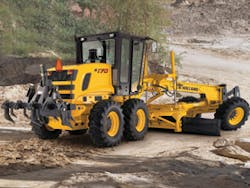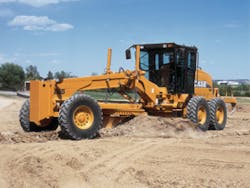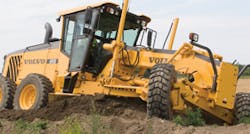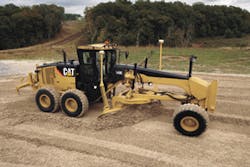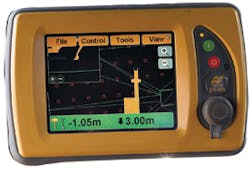If you’re looking to compare the latest motor graders among the various manufacturers, we don’t know of a better place than CONEXPO-CON/AGG 2008. So last March we attended the big show in Las Vegas and made the rounds among several grader manufacturers, who greeted us with a cornucopia of new machines and features.
Caterpillar says its new M-Series takes a “revolutionary approach” with its pair of joysticks that replace an eight-lever control system and a steering wheel. And indeed, the joysticks have generated a great deal of buzz in the industry. The M models have been in the field since early 2007, and we were curious about how customers are receiving the new machine. The answer: “Customer acceptance has been fantastic,” says Patrick Kearns of Cat’s North American Commercial Division.
With the two joysticks, one for each hand, Cat says it has greatly reduced the hand and body movement required to control the grader. “The controls are intuitive,” says Kearns. “To turn the circle you twist your right hand. To steer the grader to the left, you move the joystick left, and to steer to the right, move it right.”
Kearns says the two electro-hydraulic joysticks control the basic eight functions of the grader and an articulation return-to-center button. Logical grouping of hydraulic functions in the joystick allows for maximum operator efficiency and comfort. The result is more productivity for the customer and more comfort for the operator by reducing hand and arm movement significantly when compared to conventional controls.
With the M Series, Caterpillar solved a problem, expressed by some customers, with servicing the drawbar-circle-moldboard assembly on previous models. “We were able to greatly reduce the service time considerably over the H Series by going to a top-adjust system,” says Kearns. By removing the access plates located on the top of the drawbar, a mechanic can add shims for wear-strip adjustment or replace the wear strips at the end of useful life. Changes to the moldboard retention system and the slide-rail wear inserts make the moldboard much easier to service. The new bidirectional slide-rail shoes allow adjustment up and down as well as fore and aft.
The engines on the 800 Series from Case are electronically controlled and fuelled through high-pressure, common-rail, fuel-injection systems providing responsive control and fuel efficiency.
Caterpillar says the M Series all-wheel-drive option delivers 42% more torque than the H Series system. The M Series uses dedicated left and right pumps, which allow independent control of hydraulic flow to each front-wheel hydrostatic motor. To compensate for hydraulic power demand, the engine automatically delivers additional horsepower to provide constant net power to the ground. The new all-wheel-drive system also offers a front-wheel-only hydrostatic mode and exclusive steering compensation. Caterpillar offers the all-wheel drive with the 120M AWD, 140M AWD, and 160M AWD motor graders.
All-Wheel Drive
Over at Volvo Construction Equipment’s stand at CONEXPO, we caught up with Gary Atkinson, regional product manager with Volvo Road Machinery. He explained that the company’s G900 family of graders is a “clean-sheet-design,” resulting from a special program of customer input. Previous Volvo models had Champion grader heritage.
The G-900 family consists of seven models-two all-wheel-drive units and five tandem-drive machines. Engines range from 155 to 265 horsepower.
Notable features on the G900 family include:
- A new front axle with tighter turning radius and reduced maintenance;
- A stiffer, stronger frame;
- A new cab with a high-output air-conditioning and heating system; and
- A Tier 3-certified engine and redesigned cooling system.
“We moved to a much more technically advanced transmission,” says Atkinson. “Now we have two transmissions, the HTE 840, with eight
Volvo’s new 900 family consists of seven models with engines ranging from 155 to 265 horsepower.
forward and four reverse gears; and the HTE 1160, with 11 forward and six reverse gears.” Those transmissions use pulse-width modulation. “The goal is to provide smooth shifting from one gear to the other and better control over the shift points.”
Clutch packs typically use disks that lock up with hydraulic pressure, says Atkinson. But with modulation, the clutch packs engage gradually, so that you get a smoother shift. Shifting is electronically controlled. A vehicle electronic control unit (ECU) communicates with the engine ECU to provide control over throttle functions and transmission-related functions. There is also a third computer, an instrument ECU. The combination of those three ECUs enables the operator to control grader functions and to provide for electronic diagnostics.
The three ECUs are tied into a system called Care Track. It’s a telematics system that interfaces with the Internet through GPS satellites and provides access to a wide variety of information, such as machine hours, transmission usage in each gear, time spent in different rpm ranges, and more. The system can flag improper clutch usage, express fuel consumption, flag low engine oil pressures, and diagnose a wide variety of problems.
“This is an exceptional tool that allows for trouble-shooting of machine or operator problems from a remote location,” says Atkinson. “In many cases, mechanics can pinpoint the problem and have the required tools and replacement parts with them thus reducing the need for multiple trips to repair a failure.
Caterpillar’s new M Series of graders features a pair of joysticks in the place of the eight-lever control systems found on its older models.
“The objective is to help the equipment manager to coach his operators,” says Atkinson. “For example, if an operator can run in a higher gear at lower engine speed, we can improve fuel efficiency. Volvo’s HTE1160 transmission allows for precise control of engine rpm’s at the operator’s desired ground speed to exactly match the application at hand.”
Deere’s G-Series
John Deere introduced its new G-Series of six motor graders at CONEXPO. The Tier-3-compliant G models, which replace the D-Series, will be available in the early to mid-2009, says Jeff Rowan, product-marketing manager for motor graders.
With the new G-Series, Deere offers electric controls on the seat to replace the old mechanical controls that required hydraulic valves on each side at the floor level in front of the cab. The absence of those valves improves visibility to the ground, Rowan says. Deere will, however, continue to offer mechanical controls to those who want them-especially governmental customers.
Deere kept the steering wheel on the G-Series-or you can steer with a left-hand joystick. The joystick controls the side shift of the blade and can control steering, too.
“Customers told us they don’t want more functions on the joystick,” says Rowan. “They told us if you try to do too many things with your hand, you’ll get cross-talk of the functions.
The new electric controls allow Deere to integrate aftermarket GPSs from either Topcon or Trimble, Rowan says. “This eliminates the need to put a Deere valve on, then a Topcon valve or a Trimble valve,” says Rowan. “Our system allows you to work with Trimble or Topcon equally well.”
And now Deere has begun to offer a mid-mount scarifier. “Our old frame sloped down in front and didn’t allow us space for the mid-mount scarifier,” says Rowan. “The new frame rises higher toward the front.”
With the G-Series, Deere is using event-based shifting (EBS), not time-based shifting. Event-based shifting controls the shift based on the load being carried by the blade, not on the time it takes to fill the clutch packs. If you’re carrying a heavy load, you want a fast downshift-but you want a slower shift with a light load, which EBS gives you. “The operator doesn’t have to step on the clutch,” says Rowan. “They can shift the transmission ahead of time, and the operator can’t even tell when the machine shifts, it’s that smooth.”
New From Case
In January 2007, Case Construction Equipment announced a Tier 3 upgrade to its 800 Series motor grader line. The new engines on the 800 Series are electronically controlled and fueled through a high-pressure, common-rail, fuel-injection system. That provides responsive engine control, greater fuel efficiency, and a cleaner burn.
Increased horsepower across the entire Case motor grader line supplies additional power. The 845 DHP (dual horsepower) model maintains the horsepower range required to meet the demands of fine-grading applications, while also providing an increase of 14% for tough conditions.
The 865 VHP (variable horsepower), the most popular machine in the Case motor grader lineup, still incorporates all of the most recent enhancements to productivity while delivering an increased 205 net horsepower. Variable horsepower allows a range in power to match the needs of the application at hand by delivering better traction control and maximizing fuel economy.
“Plug and Play”
Komatsu has announced plans to introduce “Plug and Play” capability for Global Positioning Systems in the latter half of 2008. The company says either Topcon or Trimble systems will be compatible with Komatsu motor graders.
Komatsu’s Construction Equipment Division motor grader line consists of three variable horsepower models, the GD555-3 (140 net horsepower to 160 horsepower); the GD655-3 (180 horsepower to 200 horsepower); and the GD675-3 (180 net horsepower-200 horsepower). All three models are powered by Komatsu-branded engines, and all three are tandem drive. Komatsu does not currently offer all-wheel drive models.
Key features and benefits include the following:
“With the Topcon GPS, we doubled our grading production,” says Roberts. We’d still be there, if not for that GPS.” The project was completed in 2007.
“Everything ran off our 3D model of the site,” says Roberts. The 3D model, loaded on a flash card, is entered into the control box on the graders. “The advantage of the 3D GPS is that you get more accuracy on the grade. You save everybody money because you don’t overuse stone and concrete. Plus, you can grade much faster with a whole lot better accuracy.”
Roberts says the Topcon GPS cost him $120,000 for an entire system. And it paid for itself on the Dulles Airport project alone, he says, by eliminating waste of base stone and concrete pavement.
“Plus, you’d normally need three or four people checking grades and pulling stringline, but with this GPS system you cut all those people out,” Roberts says.
The Millimeter GPS relies on a laser transmitter, set up along the grade, to shoot a vertical fanshaped beam to the receivers on the motor graders. The laser beam essentially controls the height of the grader’s blade—to within 0.25 inch, Roberts says.
Wheeled Excavators
Wheeled excavators perform well on paved and unpaved surfaces and offer the ability to travel significant distances quickly—several miles, in rural environments.
Such mobility makes the wheeled excavator a valuable and versatile tool. Plus, wheeled excavators can mount virtually all of the same attachments used on tracked excavators.
A wheeled excavator is like a utility infielder—it can dig trenches, break concrete, lift and lay pipe, clean ditches, and even trim trees.
Caterpillar says its D-Series of wheeled excavators—the M313D, M315D, M316D, M318D, and M322D—deliver increased lift capacities and faster cycle times compared with the C-Series machines they replace. And Cat says the D-Series’ fuel efficiency is 7%–8% greater than that of previous models.
Each of the new D-Series wheeled excavators has added a dedicated hydraulic pump for the excavator swing function and now features a heavy-lifting mode, boosting lift capability by 7% at the touch of a button. The new systems accelerate essentially all excavator functions and produce power that the operator can feel and put to work, says Caterpillar.
The D-Series wheeled excavators range in size from 127 net horsepower with an operating weight of about 31,000 pounds to 166 net horsepower with an operating weight of about 48,000 pounds.
At Conexpo, Volvo Construction Equipment introduced a fourth model to its C-Series wheeled excavator range—the EW210C.
It’s the largest wheeled excavator produced by Volvo. The new model has a new engine and new cab as well as improved hydraulics, boom/arm, controls, and environmental impact.
The EW210C is powered by a Tier 3–compliant Volvo engine featuring the latest V-ACT (Volvo Advanced Combustion Technology) and generating 161 horsepower.
The engine produced high torque at low engine speeds, allowing fast hydraulic response and what Volvo calls “ultraefficient” fuel consumption. The engine management’s anti-stall system balances maximum available power to hydraulic output, which prevents the engine from becoming overloaded regardless of engine speed or pump demand.
At a glance, the EW210C offers a variety of features:
• Smooth, load-sensing hydraulics—A higher-torque swing motor means faster cycle times when working on slopes or placing loads.
• An improved cab—Better controls, more space, more glass, and less noise and vibration. A larger cab offers more floor space and better visibility, not to mention class-leading climate control.
• Easier service—Ground-level access makes inspection and servicing convenient and safer.
• Maneuverability—An optional two-piece boom offers increased agility, allowing the operator to work in tight spaces or perform parallel digging.
John Deere offers two models of wheeled excavators: the 121-nethorsepower Model 180CW and the 148-net-horsepower 210CW. Deere says the 210CW has a short wheelbase that allows it to slip into close quarters easily. For up-close work, Deere recommends
the two-piece boom. The one-piece boom delivers the reach and lift capacity you need for longer-distance work.
With either model, you can shift from low to high or high to low on the go. The two-speed powershift transmission in both models ensures a smooth shift every time. All controls are easy to reach, and their arrangement makes ergonomic sense.
